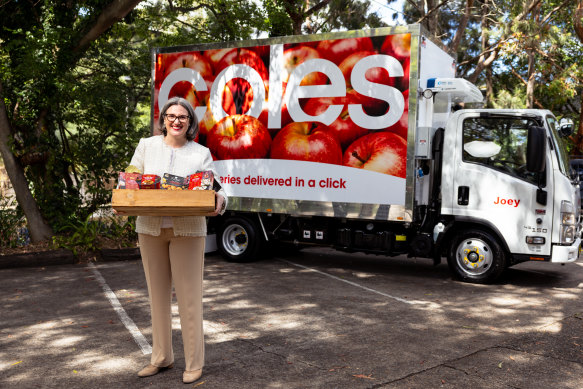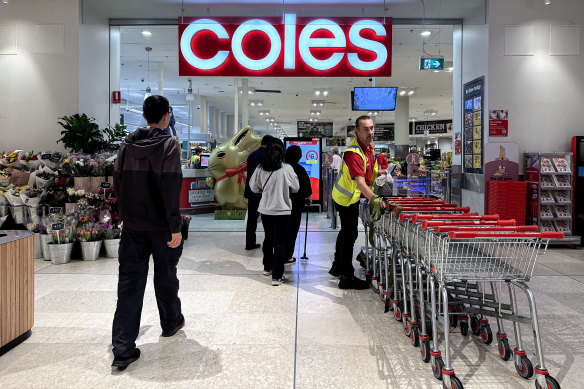This was published 7 months ago
Coles says more customers are shopping around for deals
By Kayla Olaya
Supermarket giant Coles has revealed its customers are increasingly shopping around to stretch their wallets further, going to up to seven or eight retailers in a week to find lower prices.
Speaking after the release of the company’s quarterly results, Coles chief executive Leah Weckert said that customers were focused on specials and were increasingly turning to home-branded products as they grappled with Australia’s cost-of-living crisis.

Coles chief executive Leah Weckert says shoppers are increasingly buying home-brand products.Credit: Dominic Lorrimer
This is despite Coles reporting price deflation in major categories such as meat, dairy, health and beauty, and home care categories.
“Cross-shopping is a really significant feature of the market at the moment. Customers are definitely looking for specials right now,” Weckert said.
“We’ve seen quite a substantial step-up in the last 12 months in the number of retailers that customers are using to fulfil their baskets each week on food. We’re very focused on making sure that our value proposition every week really resonates with customers, and we’re doing that through the weekly specials that we run.”
Coles reported a 2.9 per cent jump in sales to the end of September. The supermarket division was the best performer while liquor sales stalled.
The supermarket division made $9.5 billion in sales, growing by 3.5 per cent in-store and climbing to 22.4 per cent growth through online sales. Liquor, on the other hand, experienced no growth in-store and online sales dipped 1.9 per cent.
Customers are pivoting away from buying alcohol as it trickles into the category of discretionary spending and customers see this as an area of spending they can forego to balance out their budgets, Weckert said.
“About two thirds of customers that are concerned about their ability to balance the budget. At home, we’ve got about 90 per cent of our customers that are changing their behaviours with regard to grocery shopping, and they do tell us that there are lots of things that are driving budgetary constraints at home,” she said.
“The mortgage is the mortgage. The insurance bill is the insurance bill. You can’t negotiate how much you have to pay for the kids to go to school, whereas with groceries, you can make changes to what you’re buying and how you’re buying it, which can actually lead to meaningful differences in how much you’re paying.”

Coles reported a 2.9 per cent jump in sales to the end of September.Credit: Louie Douvis
Weckert said that despite customers shopping around at other retailers, they’re paying a lot more attention to new promotions and loyalty offers at Coles.
Coles and Woolworths have both reported strong growth in online grocery in their September quarter updates this week while pointing out customers were trading down to home brands.
“We continue to invest in our own brand portfolio, which offers an affordable option for the customers in most categories. That has included an expanding range that we have in both the ‘simply’, which is our entry-tier range, but also in our finer range,” Weckert said.
Amazon has emerged as a major competitor against Coles in non-grocery related items such as cleaning supplies and bin liners.
“We’ve definitely seen a lot more increased competition in the non-food space, and it’s definitely Amazon, and they offer a wide range of grocery products. But it’s not just Amazon, Bunnings now offers cleaning and pet food. Chemist warehouse and Priceline that have a lot of the lines that we would have in our medicinal and health aisles.”
Coles did not disclose its profit margins, unlike Woolworths, which saw its share price tank on Wednesday after a profit downgrade.
Weckert said Coles had a “number of headwinds coming through the business in the form of cost increases and cost inflation on our operational lines”.
Jefferies analysts Michael Simotas and Naveed Fazal Bawa noted that Coles might be “modestly out-trading” Woolworths as it didn’t mention margin pressure in its results, but that, on the downside, sales at Coles were still slightly weaker than expected.
Coles also unveiled a new $880 million distribution centre set to open in Victoria that will aid in the flow of its supply chain and product availability by contributing an additional 15 per cent more capacity to current storage facilities.
The Business Briefing newsletter delivers major stories, exclusive coverage and expert opinion. Sign up to get it every weekday morning.